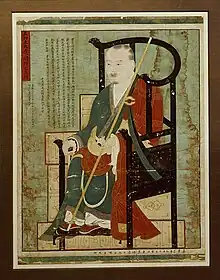| Uicheon | |
|---|---|
| Daegakguksa ('National Preceptor Grand Enlightenment') | |
 | |
| Born | Wang Hu 1055 Gaegyeong, Kingdom of Goryeo |
| Died | 1101 (age 45) Chongji Temple (총지사摠持寺), Gaegyeong, Kingdom of Goryeo |
| Burial | Yeongtong Temple (영통사靈通寺), Kaesong |
| House | House of Wang |
| Father | Munjong of Goryeo |
| Mother | Queen Inye of the Incheon Yi clan |
| Religion | Buddhism |
| Korean name | |
| Hangul | |
| Hanja | |
| Revised Romanization | Wang Hu or Wang Sukhu |
| McCune–Reischauer | Wang Hu or Wang Sŏk'u |
| Art name | |
| Hangul | |
| Hanja | |
| Revised Romanization | Woose |
| McCune–Reischauer | U'se |
| Courtesy name | |
| Hangul | |
| Hanja | |
| Revised Romanization | Uicheon |
| McCune–Reischauer | Ŭich'ŏn |
| Posthumous name | |
| Hangul | |
| Hanja | |
| Revised Romanization | Daegakguksa[1] |
| McCune–Reischauer | Taekak'guksa |
Uicheon (28 September 1055 – 5 October 1101) was a Korean Royal Prince and influential Korean Buddhist scholar-monk during the Goryeo period (918–1392). He was the fourth son of King Munjong (1046–1083) and Queen Inye from the Gyeongwon Yi clan and the younger brother of Sunjong, Seonjong, and Sukjong.[2][3]
Overview
At age 11, Uicheon volunteered to become a Buddhist monk.[4] In 1065, he studied at the Yeongtong Temple (영통사, 靈通寺) under Buddhist monk Nanwon (난원, 爛圓) who was his maternal relative and studied the Buddhist and Confucian canons.[3] Uicheon displayed exceptional talents from a young age, and he dedicated himself to the extensive study of the Chinese Buddhist canon, the works of the various East Asian Buddhist schools, along with the Chinese classics.
Uicheon lived at Ryongtongsa in Kaesong for much of his life and was buried there, where his tomb can be found. He was a prolific author, scholar and Buddhist teacher who specialized in Huayan studies and the Avataṃsaka Sūtra, having studied in China with Huayan masters.[5] He is also known for introducing the works of the Cheontae school to Korean Buddhism.[6] He was also known by the title Daegak Guksa (大覺國師, "State Preceptor Great Awakening ").
Uicheon's reputation eventually reached China, and he eventually was patronized by Chinese Emperor Zhezong. Uicheon and his party eventually visited the Song Dynasty capital and met with Emperor Zhezong. Subsequently, they visited several prominent monasteries such as Jingyuan Monastery (淨源寺) and Yanglian Monastery (懹璉寺), where they engaged in discussions with over 50 eminent monks. Uicheon made many connections with Chinese masters during this time, particularly with scholars of Huayan sect such as Jinshui Jingyuan (靜源, 1011-1088) with whom he continued to exchange letters after returning to Korea. Jingyuan also sent Uicheon Huayan texts.[5]
Uicheon also visited the Liao dynasty, visiting various key sites and meeting with Liao monks. He even became a priest for Emperor Daozong of Liao before returning to Korea.
Back in Korea, Uicheon's reputation had continued to grow and he was warmly welcomed. King Seonjong recognized the importance of reviving Buddhism and invited Uicheon to assume the position of head monk at Heungwang Temple. He established a repository for the scriptures at Heungwang Temple and also collected scriptures from China and Japan. He published the "Collection of the Avataṃsaka Sūtra" (화엄소초), which consisted of more than 4,740 volumes.
From 1073 to 1090, Uicheon collected numerous Buddhist commentaries from Korea, China, the Khitan Empire and Japan, which were published as the "Goryeo Catalog of Sutras" (or "Goryeo Supplement to the Canon").[7]
In his later life, Uicheon continued his long distance engagement with Song Dynasty scholars while also teaching Korean disciples. His legacy includes compilations such as "New Compilation of the Teachings of the Seon Sect" (신편제종교장총록), and "Songs and Trees of the Stone Garden" (석원사림), among others.
Works
- Sinpyeonjejonggyojangchongnok vol. 3 (신편제종교장총록 3권)
- Sinjipwonjongmullyu vol. 22 (신집원종문류, 新集圓宗文類 22권)
- Seokwonsarim vol. 250 (석원사림, 釋苑詞林 250권)
- Daegakguksamunjib vol. 23 of deeds and poems (대각국사문집, 大覺國師文集 23권 행적과 시 문집)
- Daegakguksawoejip vol. 13 (대각국사외집, 大覺國師外集 13권)
- Ganjeongseongyusiknondangwa vol. 3 (간정성유식론단과, 刊定成唯識論單科 3권)
- Cheontaesagyouiju vol. 3 (천태사교의주, 天台四敎儀註 3권)
See also
References
- ↑ Guksa was his title (‘National Preceptor’), while Daegak was his posthumous Dharma name, meaning "Grand Enlightenment".
- ↑ Jae-eun Kang (2006). The Land of Scholars: Two Thousand Years of Korean Confucianism. Homa & Sekey Books. p. 108. ISBN 978-1-931907-37-8.
- 1 2 "Encyclopedia of Korean Culture (한국민족문화대백과사전), Entry for 의천". Retrieved 14 August 2023.
- ↑ Encyclopedia of Korean Culture (한국민족문화대백과사전), entry for 의천.
- 1 2 McBride II, Richard D., Uichon and the Golden Age of Koryo Buddhism - Nam Center for Korean Studies Colloquium Series 1/12/2011, retrieved 14 August 2023
- ↑ Buswell, Robert Jr; Lopez, Donald S. Jr., eds. (2013). Princeton Dictionary of Buddhism. Princeton, NJ: Princeton University Press. pp. 912–913. ISBN 9780691157863.
- ↑ Sang-jin Park (18 September 2014). Under the Microscope: The Secrets of the Tripitaka Koreana Woodblocks. Cambridge Scholars Publishing. p. 23. ISBN 978-1-4438-6732-0.
External links